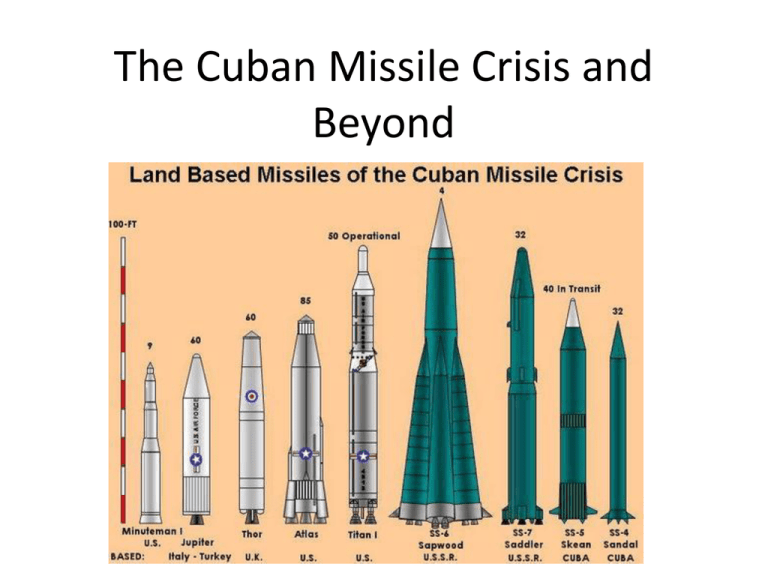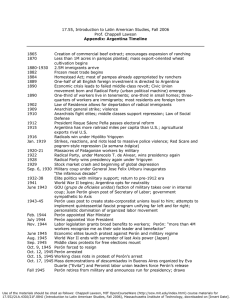The Cuban Missile Crisis and Beyond
advertisement

The Cuban Missile Crisis and Beyond • Fidel Castro took control of Cuba in 1959 and declared himself a communist. • The United States aided Cuban dissidents in a failed attempt to overthrow Castro in 1961. • Soviets try to put missile launch pads in Cuba in 1962, leading to the Cuban Missile Crisis. • Leads to Nuclear Test Ban treaty in 1963 • Bans aboveground testing and development of nuclear weapons • American veterans of World War II returned home and created the “baby boom.” 1946 – 1964 • Conservative middle class values and consumerism dominated postwar era. • Large families standard – aided by improved medical care and diet. • Mass consumerism for necessities and luxury goods became the norm. • Americans borrowed, while Europeans saved, to buy consumer durables such as televisions and refrigerators. • The G.I. bill enabled many veterans to go to college. • Tupperware typifies the new consumer era: Americans had food surpluses to store and large families to feed. • Middle class life gender segregated by work (men) and home (women). • American pop culture dominated world, due to radio, television, and movies. • American music, from blues, jazz, to rock and roll standard worldwide. • In Europe, existentialism offered an alternative to American materialist modernism. • Martin Heidegger – Influenced French intellectuals such as – Sartre and Camus. • Sartre viewed communist socialism as egalitarian. • Camus was anti-communist who thought engagement was the only way to escape the absurdity of modern existence. • Existentialism – Philosophical thinking begins with the individual – The individual is disoriented and confused – The world is absurd • Literature, film, and art explored themes of: – Individualism – Conformity – Alienations – Mass murder – Gender – Race – Political persecution • American authors explored the complexity of modernism in the postwar period. – William Faulkner – Tennessee Williams – Elizabeth Bishop • British writers wrote about personal struggles with modernity: – W. H. Auden – Dylan Thomas • German writers focused on identity, guilt, and truth in language: – Max Frisch – Günter Grass • Latin American writers explored the ambiguities of modernity. – Jorge Luis Borges – Pablo Neruda – Octavio Paz • Erich von Stroheim and Jean Renoir pioneered the “art film” which included: – Neorealist • • • • Bicycle Thieves La strada The Hustler The French Connection – New Wave film • Breathless • Jules and Jim • Painting: abstract expressionism. • Rothko and Pollock’s Mark Rothko Jackson Pollock • Social realism was also popular with artists, especially in Mexico. Populism and Industrialization in Latin America • Latin American stayed out of World War II, and remained economically stagnant. – Depression of the 1930s reduced Latin America’s exports in commodities. – Leaders tried to industrialize by import substitution, making goods domestically. • Latin American slowly urbanized after 1945 but led to more income disparity. – Landless migratory workers settled in shantytowns in the cities. – “Informal sector” of peddling, repairing, and recycling developed. – Living in cities did provide educational and health opportunities. – Industrial labor force small, most Latin Americans worked on farms. • Only Mexico and Brazil developed basic industrial goods: steel and chemicals. • Latin American states chose populism rather than capitalism or communism. – Emphasis on appealing to the ordinary people and their interests. – Venezuela, Colombia, and Costa Rica tried democracy in the 1950s. – Eight nations had populist regimes, including Argentina and Brazil. – Remaining Latin American states had authoritarian dictatorships. • Populism typified by “Peronism” – The rule of Argentina by . • Perón was part of a military junta that seized Argentina in 1943. • Sympathized with urban workers, informal sector, and traditional crafts. • Negotiated with unions for higher and minimum wages, and pensions. • Married Eva Duarte, who managed charitable social organizations. • Perón elected president of Argentina in 1946 and begins to industrialize and nationalize utilities and transportation. • Perón also nationalized iron, steel, and construction industries. • Machinery had to be imported and Truman refused to send Marshall Plan aid. • Perón would serve a third term as president, 1973 – 1974 – His second wife Isabel Martínez de Perón would be president from 1974 – 1976 The End of Colonialism and the Rise of New Nations • Chinese communists won control of China in 1949, after a ten-year civil war. • Mao Zedong adapted Marxism for peasants, communal farms, and decentralized village industrialization. • Land reform took land from landlords and distributed it to peasants. • As many as 2 million landlords who resisted were killed. • Began slow collectivization, using incentives to get peasants to share tools and machinery. • Mao’s “Let A Hundred Flowers Bloom” asked intellectuals for suggestions for reform. – Intellectuals complained more than expected and tried to start a second party. – By 1957 Mao is concerned that the intellectuals had gone too far. – Intellectuals were arrested and sent off for “reeducation.” • Mao launches Great Leap Forward, 1958– 1961 to speed up farm collectivization. – Farms were collectivized, with people living in barracks. – Small backyard steel furnaces were built, and farm implements melted down. – Peasants resisted seizure of land and farming tools. • By 1962 some 30 million had died from famine. Palestine Israel • Britain handed the problem of Palestine over the United Nations. • Created the state of Israel, which declared its independence in 1947. – Soviet Union allowed 200,000 Jews to immigrate to Israel. – Soviets sent weapons and planes, helped Israel to fight Arabs. • The United States and Britain placed embargo on weapons to Arabs to help Israel. • Palestinians fled from Israel and Jews were expelled from Arab lands. 600,000+ Jews immigrate to Israel, 1947-1951 • Colonel Gamal Abdel Nasser seized control of Egypt in a coup in 1952 and set up a military state. • Led the “Free Officers” in land reform, to break up large estates • Opposed by Muslim Brotherhood, who tried to create an Islamic state. • Nasser outlawed the Muslim Brotherhood in 1954. • Once in office (as president) Nasser promoted Arab nationalism. • Supported by Soviets with weapons and in building the Aswan Dam. • Nationalized the Suez Canal from Britain and France. • Closed Straits of Tiran in 1956, a major shipping lane for Israel, but forced to reopen it after the Suez War. • Britain and France no longer a player in Middle East politics. • The United States inherits British interests in the area, to protect oil. • Nasser part of Non-Aligned Movement in 1961, independent of superpowers (Bandung Conf.). – Nasser of Egypt – Sukarno of Indonesia – Tito of Yugoslavia India • Before and during the World War III three groups had vied for control of Indian subcontinent. – Indian National Congress wanted a secularized state modeled on Britain. – Muslim League wanted a separate religious state for Muslims – Hindu religious nationalists wanted Indian identity tied to Hinduism. • 1947 British divided subcontinent into independent Pakistan and India. – Nearly two million people crossed the borders, and hundreds of thousands died in the exchange. – Pakistan divided in 1971, when Bangladesh declared its independence. • First war between India and Pakistan in 1947 over the Kashmir. – Region led by a Hindu prince but had a Muslim majority. – India conquered most of it, but still a source of dispute. • New nation of India adopted a British parliamentary and court system. • Led by Jawaharlal Nehru, India’s first prime minister. • Adopted five-year plans from Soviets to increase agricultural output. • Most pressing problem was poverty and overpopulation. • India was a hybrid capitalist-socialist state with private property and socialist state investments. • State socialism focused on nationalizing heavy industry with loans and hampered by poor tax collection and food shortages. The French Empire • France wanted to restore its empire after World War II • The first problem was in French Indochina • The United States aided Vietnamese communists to fight Japanese in World War II. • Ho Chi Minh, leader of communists, declared Vietnam independent in 1945. • French convinced the United States to help, to prevent victory for communists. • Geneva Conference, 1954 – French defeated in Vietnam – Negotiated a division of Indochina into: • Two Vietnams • Laos • Cambodia. • The United States sent military aid to South Vietnam, first advisors then ground troops soldiers. • Communist guerillas fought in South Vietnam and in Laos. • In 1963 the South Vietnamese Army assassinated Ngo Dinh Diem • United States continues to support the military government in the South. • Europe began to pull away from sub-Saharan African colonies in 1950s, as the cost of holding on to them became too high. • Europe tried to influence new governments to be friendly with former colonial powers. • Europe had not developed African colonies, which needed large investments to build up industries. – Continued to rely on commodities exports. • Ghana (Gold Coast), under Kwame Nkrumah, became independent of Britain in 1957. – Had a strong economy based on cocoa, and strong middle class. – Nkrumah overthrew the British inspired constitution in 1959 and – Eventually turned Ghana into a one-party state. • Overthrown by a military coup, aided by the United States, in 1966. • Belgian Congo became a Cold War battlefield in the 1960. • National elections were held in 1960, and nationalist Patrice Lumumba won. • Lumumba became prime minister on a centrist platform. • Lumumba alienated the Belgians and the Congolese Army (which had Belgian officers). • Order began to break down. • Katanga province tried to break free, with Belgian support. • Lumumba brought in U.N. peacekeepers to restore order, but also took aid from Soviets to force Katanga to rejoin Congo. • Divisions in government allowed Mobuto to stage a coup and have Lumumba killed, with the collusion of – Belgian – Britain – The U.S.







